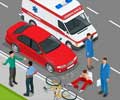World Red Cross Day is observed on May 8 every year. The red cross you see across every healthcare unit in the city, isn't the symbol for the doctors. It's the icon of the Red Cross Society, a voluntary humanitarian organization providing relief in times of disasters/emergencies and promotes healthcare of the vulnerable people and communities.
It became so popular ever since its origin that almost all healthcare workers started to identify themselves with the symbol. The society is still fighting to have this rectified.'When the British Ruled India there were no organisations that could provide relief services to the soldiers injured in the first world war 1914. Sadly, most of them were Indians and they had no medical attention,' says B. Chandrashekar, a 80-year-old-volunteer. 'There was just a branch of the St. John Ambulance Association. And it could not cope with the huge casualty,' he said.
In March 1920, a bill to constitute the Indian Red Cross Society, Independent of the British Red Cross, was introduced in the Indian Legislative Council by Sir Claude Hill, member of the Viceroy's Executive Council. It became an Act the same month.
On 7th June 1920, fifty members were formally nominated to constitute the Indian Red Cross Society and the first Managing Body was elected from among them with Sir Malcolm Hailey as Chairman. And since then their service to humanity began.
With a mission 'to inspire, encourage and initiate at all times all forms of humanitarian activities' it has aimed at minimising suffering and created more congenial climate for peace.
The society has been dealing a series of activities that include hospital services, blood bank, HIV/AIDS programmes, home for disabled servicemen,vocational training centers, tracing activities, maternity, child and family welfare, nursing, junior red cross activities, preparedness and prevention of communicable and infectious diseases, relief operations in fire, railway and other accidents and events.
The impact of disasters are high. It leaves people traumatised by the death of bread winners, children are orphaned and houses are lost. 'It's a complex situation. Bringing emergency relief to refugees and victims of poverty and disasters has been our key activity,' says a doctor at the St Johns Medical College, Bangalore.
They have been organising VOCATIONAL TRAINING CENTREs that provides opportunities to increase vocational skills and the earning opportunities of low-income groups and to raise the status of women socially and economically by making them available opportunities for learning and leadership.
The Red Cross MCW units teach home nursing skills to auxiliary nurses, midwives and housewives.
'We have the best quality of nurses or nannies who come home. They are school drop outs who are trained to do the job. They are most wanted not just because they don't over charge but also because they know hygiene is important,' says Dr S Manohar, a Bangalore-based family consultant.
Source-Medindia







